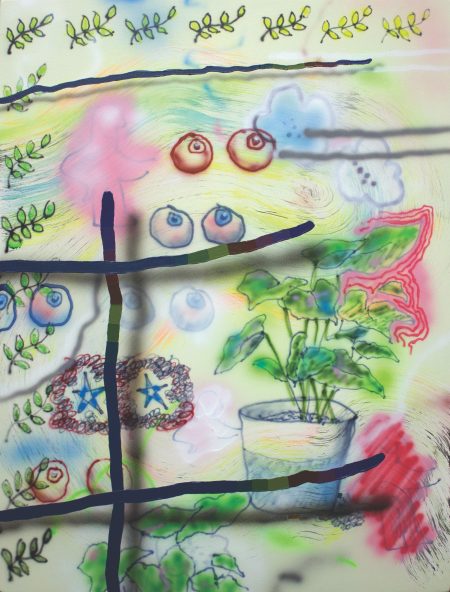Currently situated within Swanson Contemporary are paintings and installations composed of paintings situated within murals that make up Benjamin Cook’s exhibition, History Abridged—they’re fun, they’re difficult, they’re comedic, and they’re nostalgic. The show could easily feel overworked with this much imagery—but it doesn’t. It references a certain conflicting brevity of time and expansion of time that interacting with internet spaces can stimulate. The exhibition locates the audiences’ learned short attention span and is playing with it; it’s keenly manipulative and smart. The exhibition references internet dynamics and digital theory, painting as situational installation, architecture as a historical element as well as pop culture.
Benjamin Cook is a painter and curator living in Covington, Kentucky. His work has been exhibited internationally and he has been published in numerous magazines. According to his biography, Benjamin’s work “combines abstract mark making with strategies of digital protocol to explore the space between the binaries of digital and physical space”.
Cook’s paintings depict images that appear to be broken down into three planes that exist as layered spaces as well as layered stylized marks. The first (or bottom) being a relatively solid, squeegeed space, intended as a neutral ground for the placing the second and third layers. The second layer consists of airbrushed, sketchy images of, or referential to, pop culture as well as recognizable / stylized icons (football helmets, Snoopy, coffee mugs, skulls, plants, etc). The third layer consists of hard lined, multi colored snake like figures that seemingly sit inflexible on top of the viewing plane, with a subtle (wonderfully rendered) shading directly under the snake-like figure. This subtle shadow, though excellently rendered to create illusionistic depth, when read within a contemporary context, reads purely digital and allows the viewer curiosity as to what type of image they are looking at: the entire exhibition pushes the viewer to wonder what these works look like digitally (which I had seen in a digital format prior to the exhibition, and they do read differently). This is clearly intentional: to quote the artist, “As a single object, the paintings perform as highly polished illusions on digital screens and laborious flawed artifacts on the wall.
Paired with the exhibition is a document titled, An Open Letter, which is followed by the opening statement, “Please stop using the term “Real World””. In which Cook continues to extrapolate the difference between our usage of the term “real” as it relates to describing situational relationships on the internet versus, well, not the internet. This pairing of a document alongside the exhibition is Cook placing his curatorial authority on to the exhibition, whether it was intended or not— creating a compartment or lens for the viewer to examine the work—and pulling all of the control in his direction. The complication that this letter creates is interesting, but I could easily see how it could be distracting from the exhibition, or even an inhibitor, as providing too much information can often do. It simply depends on the viewer and how they intake new information, I suppose. I’ve included excerpts from the document:
The terms “real world” or “real life” are used to ascribe the term “real” to a physical world within the context of opposition to a digital world. This creates a dichotomy that assumes the pejorative non-real or less-than-real title for digital space. Experiences that exist through a screen may seem detached due to the level of mediation, but they are just as real as anything else. . . Beyond our understanding of digital and physical space, and beyond the language that we use to talk about it, this is an issue of combating binaries. Often when we are presented with a new idea, it is our default setting to try to understand it through touchstones of the world that we know. . . By admitting that you don’t have the answers and are unable to classify, quantify, or place an idea within a specific category, you allow yourself to ask questions about meaning and experience.
In summation, this is a strong exhibition filled with thought and curiosity on our ever developing idea of how we should relate to the internet and what it means as a communal space that needs to be shared and safe for everyone. It asks that we look at our language for this shared space, and it asks that the viewer be thoughtful in how they consume images and information found through said space. It’s an important aesthetic and ethical quandary that is still in search of thorough debate and is ever evolving and I was happy to see a contribution to said debate resting in Louisville, Kentucky.
—Megan Bickel






